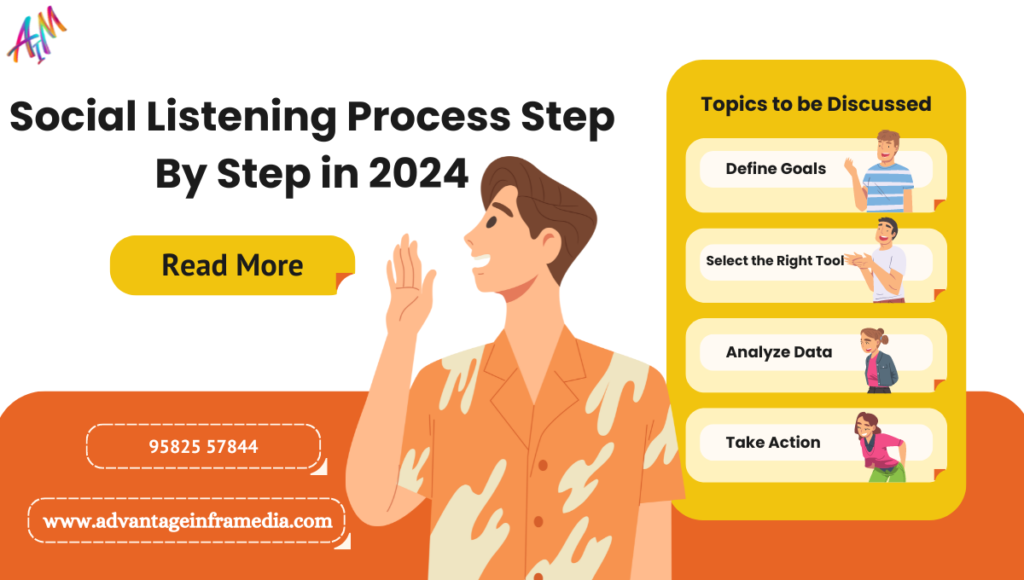Introduction
Social listening is more than just a buzzword; it’s the secret weapon that helps digital marketers tap into the pulse of consumer conversations across social media platforms. With the advent of technology that analyzes consumer sentiment, the opportunity to harness social listening has become one of the most significant levers for growth and engagement in digital marketing. This blog explores the social listening format, its strategies, best practices, and why it is the biggest opportunity in digital marketing today.Understanding Social Listening
- Definition: Social listening is the practice of tracking online conversations about your brand, industry, competitors, and relevant keywords to understand consumer sentiment and identify actionable insights. It moves beyond mere monitoring to include analysis and strategic actions.
- The Difference Between Social Monitoring and Listening: While social monitoring focuses on tracking metrics (e.g., mentions, likes), social listening focuses on understanding the context, sentiment, and deriving insights to improve brand perception and marketing strategies.
- How It Works: Social listening tools aggregate data from platforms like Twitter, Facebook, Instagram, Reddit, and forums. They use natural language processing (NLP) to analyze sentiment and categorize conversations.
Why Social Listening is Crucial for Digital Marketing
- Consumer Insights: Social listening provides a direct insight into what customers think and feel about a brand, its products, and even competitors. These insights drive more informed decisions in product development and customer experience.
- Crisis Management: Social listening allows marketers to identify potential PR crises before they escalate. Identifying a spike in negative mentions can help brands take action and resolve issues quickly.
- Improving Campaign Performance: Social listening helps digital marketers understand the effectiveness of campaigns. By gauging customer reactions, brands can pivot their marketing strategies in real time.
- Competitor Analysis: Track competitors’ mentions and industry conversations to identify opportunities or gaps. Understand what works for others and gain insights into areas where your brand could improve or capitalize.
The Social Listening Format: Breaking It Down
- Components of a Social Listening Strategy:
- Qualitative vs. Quantitative Analysis: Social listening incorporates both qualitative and quantitative analysis. While quantitative involves numbers (e.g., mentions count), qualitative insights delve into understanding sentiments, emotions, and reasons behind the numbers.
Tools for Effective Social Listening
- Sprout Social: One of the leading platforms for social media management, providing social listening features that help brands understand conversations in real-time.
- Hootsuite: Offers a social listening feature that allows users to track and manage social media mentions effectively.
- Brandwatch: Provides deep insights into consumer behaviors and industry trends using advanced NLP technology.
- Mention: Monitors the web, providing real-time alerts on any mention of your brand or relevant keyword, helping in proactive crisis management.
- Key Features of Social Listening Tools:
- Sentiment Analysis: Understanding whether conversations are positive, negative, or neutral.
- Keyword Tracking: Monitoring specific keywords or hashtags.
- Competitive Analysis: Insights into competitors’ brand health and customer sentiment.
Benefits of Social Listening in Digital Marketing
- Content Creation: Social listening helps identify what topics resonate most with your audience. By identifying trending topics or frequently asked questions, marketers can craft content that directly addresses consumer needs.
- Customer Service: Brands can use social listening to improve customer service. By proactively responding to customer issues or complaints raised online, brands can create a positive experience that’s visible to a broader audience.
- Identifying Influencers: Social listening can help you identify potential influencers who are already talking about your brand or niche. This allows for more authentic influencer partnerships.
- Brand Reputation Management: Tracking brand mentions helps you understand how people perceive your brand. Quick responses to negative mentions can enhance reputation and show customers that you care.
- Product Development: Listening to customer feedback on your products helps companies make better-informed decisions when it comes to product improvement and development.
Best Practices for Social Listening
- Be Consistent: Social listening should be a consistent practice. Insights change frequently, and ongoing tracking is crucial to stay up-to-date with consumer opinions.
- Engage Authentically: Engaging with users based on what you learn is vital. A brand that responds to concerns, thanks customers for positive mentions, or takes feedback seriously is seen as authentic.
- Segment Your Audience: Use social listening to understand different segments of your audience. Tailor your communication and campaigns to each segment to increase relevance and engagement.
- Track Competitor Mentions: Understanding how audiences react to competitors helps you identify industry gaps or opportunities to distinguish your brand.
- Adapt and Improve: Use the insights to constantly adapt your marketing strategies. If a campaign isn’t resonating as expected, social listening provides clues on how to adjust.
Case Studies: Brands Leveraging Social Listening Effectively
- Netflix: Netflix is known for actively listening to its audience. By analyzing social media trends, Netflix can align its promotional strategies to match audience preferences, sometimes even creating memes based on viewer reactions.
- Nike: Nike has successfully used social listening to promote campaigns that focus on social issues. The #JustDoIt campaign was boosted by listening to the audience’s desire for more representation and support for movements like Black Lives Matter.
- Domino’s Pizza: After noticing a lot of negative sentiment about their pizzas, Domino’s launched the “Pizza Turnaround” campaign, using social listening insights to improve their recipe and address consumer complaints directly, which led to improved brand perception.
Challenges in Social Listening
- Data Overload: One of the main challenges of social listening is dealing with massive amounts of data. Filtering out the noise to focus on relevant insights is essential.
- Sentiment Analysis Accuracy: Natural language is complex, with sarcasm, slang, and nuances that can be hard for social listening tools to interpret accurately.
- Privacy Concerns: Respecting user privacy is critical. Overstepping boundaries by collecting too much information or appearing invasive can backfire.
- Platform Restrictions: Each social platform has its own set of rules regarding data access. As a result, some platforms may limit the insights that can be gathered, especially as they evolve their privacy policies.
Future of Social Listening
- AI and Machine Learning: The future of social listening lies in AI and machine learning. These technologies will make it possible to analyze large amounts of data in real-time, providing more precise sentiment analysis and identifying trends faster.
- Integration with Business Intelligence: Social listening will become a core part of business intelligence, connecting the insights to other data points like sales, CRM, and market research.
- Voice and Video Content: As voice and video become more dominant forms of content, social listening will also evolve to include analysis of these formats, using AI to capture and analyze conversations in voice-based platforms like podcasts or Clubhouse.
- Predictive Analysis: Future tools might be able to predict market shifts and consumer needs based on trends seen in social conversations, allowing brands to act proactively rather than reactively.
Social Listening for Different Industries
- Retail: For retailers, social listening helps identify the hottest trends, understand customer pain points, and manage product launches effectively.
- Healthcare: Healthcare organizations use social listening to understand patient concerns, monitor public sentiment during health crises, and provide timely information to patients.
- Hospitality: In the hospitality industry, monitoring reviews and customer feedback is key. Social listening allows hotels and resorts to address concerns quickly and improve guest experience.
- Tech Industry: The tech industry relies heavily on social listening to gain insights into user experiences and to improve products and services based on feedback.
Detailed Steps to Develop a Social Listening Framework
Implementing social listening effectively requires more than just having the right tools. Here are detailed steps to create a robust social listening framework that works for your brand:Set Clear Objectives
Before diving into social listening, it’s essential to define what you hope to achieve. Objectives may include:- Improving brand reputation
- Gauging customer satisfaction
- Understanding competitors’ strengths and weaknesses
- Identifying emerging trends in your niche
- Monitoring campaign performance
Identify Key Topics, Keywords, and Platforms
- Key Topics: Identify the topics most relevant to your brand, industry, or upcoming campaign. Consider current events that may impact your audience’s behavior or perception.
- Keywords: Keywords form the basis of your social listening. Choose branded keywords (brand name, product names) and non-branded keywords (industry-related, trending hashtags). Competitor brand names can also be included.
- Platforms: Not every platform may be relevant to your brand. Focus on platforms where your audience is most active. For B2B companies, LinkedIn may be essential, while B2C brands may find Twitter, Facebook, and Instagram more crucial.
Select the Right Tools for Social Listening
With numerous tools available, the choice depends on your objectives, budget, and depth of analysis required:- Hootsuite: Offers customizable streams for tracking mentions, hashtags, and topics across major platforms.
- Sprout Social: Provides detailed analytics and easy collaboration for large marketing teams.
- Awario: Ideal for small to medium-sized businesses, Awario tracks mentions in real-time, offering a cost-effective solution for monitoring brand health.
- BuzzSumo: Focuses on content performance and helps identify influencers.
Create a Reporting System
- Dashboards: Create dashboards for easy visual analysis. These should show the most important metrics, such as mentions over time, sentiment breakdowns, and key influencers.
- Custom Reports: Generate custom reports to highlight specific data points. For instance, during a product launch, a report might focus on positive versus negative mentions.
Set Up Alerts
Configure alerts to notify you in real-time when your brand or keywords reach a particular threshold. Alerts are particularly useful for:- Tracking spikes in negative sentiment.
- Identifying opportunities for positive brand engagement.
- Monitoring high-profile mentions (e.g., by celebrities or industry leaders).
Measuring Social Listening Effectiveness
Social listening can be resource-intensive, so it’s crucial to measure its effectiveness in driving results. Key performance indicators (KPIs) include:Brand Awareness and Share of Voice
- Brand Awareness: Track mentions and reach to gauge how well-known your brand is among your target audience.
- Share of Voice (SoV): Measure your brand’s share of the conversation compared to competitors. A rising SoV indicates increased market influence.
Sentiment Analysis
- Monitor how sentiment changes over time. Improvement in sentiment suggests successful campaigns, better customer engagement, or effective PR responses.
Campaign Performance
- For specific campaigns, use social listening to evaluate how well a campaign resonates with your audience. Are people talking about it positively? Are there any notable complaints or misconceptions?
Engagement Metrics
- Engagement Levels: Track engagement metrics, such as comments, likes, shares, and replies, to see how effective your responses are.
- Influencer Engagement: Track how influencers and opinion leaders engage with your content.
Crisis Management Impact
- Track how quickly and effectively issues are resolved when identified through social listening. Reduced time to resolve an issue indicates good social listening integration.
Advanced Social Listening Techniques
To extract more advanced insights, social listening needs to go beyond simply tracking mentions. Here are some advanced techniques:Trend Analysis
Analyzing trends allows brands to predict the direction of consumer behavior and adjust their strategies accordingly. Social listening tools can help by:- Identifying Emerging Keywords: New keywords that suddenly increase in frequency can indicate emerging consumer interests.
- Tracking Influencer Mentions: Identifying trends among influencers can provide an early indication of shifts in consumer expectations.
Sentiment Drivers
- It’s not enough to know if the sentiment is positive or negative; understanding the drivers behind sentiment helps you create impactful strategies. Analyze why people feel the way they do. This could involve diving deep into negative mentions to understand product flaws or identifying why customers prefer a competitor.
Emotional Analytics
- Beyond sentiment, emotional analytics goes a step further by identifying the exact emotion conveyed (e.g., joy, anger, surprise). Understanding the emotional context helps tailor responses to align with your audience’s current feelings.
Identifying Pain Points
Social listening can uncover common pain points or frustrations with your industry or products. A classic example is how Domino’s Pizza addressed customer dissatisfaction by completely revamping their recipe and creating a transparent “Pizza Turnaround” campaign to show how they listened and acted.Building Brand Advocacy with Social Listening
A powerful application of social listening is turning engaged consumers into brand advocates. Here’s how:Identify Brand Advocates
- Use social listening to identify customers who consistently speak positively about your brand. These individuals can be excellent candidates for advocacy campaigns.
Personalized Engagement
- Engage directly with these advocates through personal interactions. Mentioning them in a post, rewarding them with special discounts, or simply thanking them can create loyal advocates.
User-Generated Content (UGC)
- Encourage brand advocates to share their experiences. Use social listening to identify posts that can be repurposed as UGC, which tends to be more trusted than branded content.
Building a Community
- Create exclusive groups, such as Facebook or LinkedIn groups, for brand advocates. Regularly engage with them, and make them feel like a vital part of your brand community.
Social Listening for Crisis Management: A Practical Guide
Social media crises can emerge out of nowhere, and social listening plays a pivotal role in mitigating their effects. Here’s a practical guide:Monitor Crisis Indicators
- Set up alerts for potential crisis indicators such as a sudden spike in negative mentions, unusual engagement on a post, or multiple mentions from influencers.
Respond Quickly and Authentically
- Use the insights gathered from listening to understand the root cause of the issue. Respond quickly to acknowledge the situation and provide a path to resolution. Brands like Wendy’s have mastered the art of authentic responses that resonate with audiences.
Assess Post-Crisis Sentiment
- After implementing a crisis response, use social listening to track audience reactions and understand whether the sentiment is improving. This allows you to refine your approach and address any residual issues.
Learn from Mistakes
- Post-crisis, evaluate what went wrong and how to avoid a repeat. Analyze conversations to identify the key reasons the crisis occurred, and implement measures to prevent future issues.
Industry-Specific Social Listening Strategies
Different industries can leverage social listening in unique ways to derive maximum value:Retail and eCommerce
- Track Competitor Promotions: Stay updated with competitors’ promotional activities. By monitoring consumer reactions, your brand can refine promotional tactics to meet the current mood.
- Product Feedback: Collect product-specific feedback to improve offerings. If a competitor’s product is receiving negative feedback for a particular feature, your brand can capitalize by promoting an improved version.
Food and Beverage
- Monitor Consumer Preferences: Track shifts in consumer tastes, like veganism or interest in organic products. Brands can adjust offerings to align with these preferences.
- Seasonal Campaigns: Track consumer sentiment around seasonal campaigns (e.g., holiday menus) and adjust offerings to match consumer tastes.
Travel and Hospitality
- Guest Experience Tracking: Understand which experiences guests love or dislike. Use positive reviews to promote strengths while acting on negative feedback to improve.
- Location-Specific Trends: In hospitality, understanding trends in specific locations can help hotels improve their services and align with regional preferences.
Financial Services
- Customer Sentiment About Fees and Policies: Banks can track what people think about their fees, services, or digital banking experiences. This insight is crucial to keep improving offerings and customer satisfaction.
- Financial Advice Trends: Understanding what financial advice consumers are seeking can help banks and insurance companies shape their content strategy to educate and assist customers.
Social Listening Data Privacy and Ethical Considerations
Privacy is an increasingly critical consideration for brands using social listening. Here are some of the best practices to adhere to ethical standards:Be Transparent
- Disclosure: When responding to customer comments or feedback derived through social listening, be transparent that your brand is listening and values customer feedback.
- Avoid Intrusiveness: Use aggregated data to understand trends rather than focusing on individual customer data unless they have explicitly reached out for a response.
Comply with Data Regulations
- Ensure compliance with data privacy regulations like GDPR (General Data Protection Regulation). Ensure that personal information is anonymized wherever possible, and only publicly available data is used for analysis.
Avoid Over-Monitoring
- Listening to public posts is acceptable, but over-monitoring, or tracking private or sensitive conversations without consent, could damage a brand’s reputation and lead to legal complications.
Case Studies: Social Listening Success Stories
Netflix – Content Adaptation
Netflix is known for using social listening to track viewer preferences and feedback. Their popular series “Stranger Things” benefited from this. The company monitored viewer conversations to gauge interest in specific genres and used this insight to market the show to fans of sci-fi and ’80s nostalgia effectively.Wendy’s – Real-Time Engagement
Wendy’s uses social listening to engage with its audience humorously. Their witty comebacks and authentic tone have led to increased engagement and brand love, helping them differentiate themselves in the fast-food industry.Coca-Cola – Crisis Averted
When a particular tweet regarding a bad product experience went viral, Coca-Cola was quick to respond, thanks to social listening alerts. They handled it by offering the customer a personalized response, free products, and a public apology, which helped mitigate any negative fallout.Social Listening Challenges and How to Overcome Them
While social listening is powerful, it’s not without its challenges:Information Overload
- The sheer volume of data can be overwhelming. To overcome this, ensure you have well-defined filters, segmented listening dashboards, and regularly scheduled data analyses.
Context Misinterpretation
- Understanding the context of mentions can be challenging, especially with sarcasm or regional language differences. Using a tool that offers advanced sentiment analysis and emotional analytics helps reduce misinterpretation risks.
Tool Limitations
- Not all tools can capture every platform or regional data. To address this, use a mix of tools to cover as many platforms and regions as possible or customize existing tools to extend their capabilities.
Conclusion: Leveraging Social Listening to Stay Ahead
Social listening is no longer just an add-on to social media strategies; it’s a critical component of digital marketing that directly affects your brand’s growth, reputation, and customer loyalty. By effectively implementing social listening, brands can gain a deeper understanding of their audience, stay ahead of the competition, mitigate crises before they escalate, and continuously innovate their offerings. Social listening transforms what was once a one-way broadcast into a dynamic conversation, where brands not only hear their audiences but act on their needs, fostering stronger connections and loyalty. By staying aware, responsive, and adaptive, companies can leverage the true power of social listening to lead their industries and create an irreplaceable bond with their customers.
Post Views: 17




